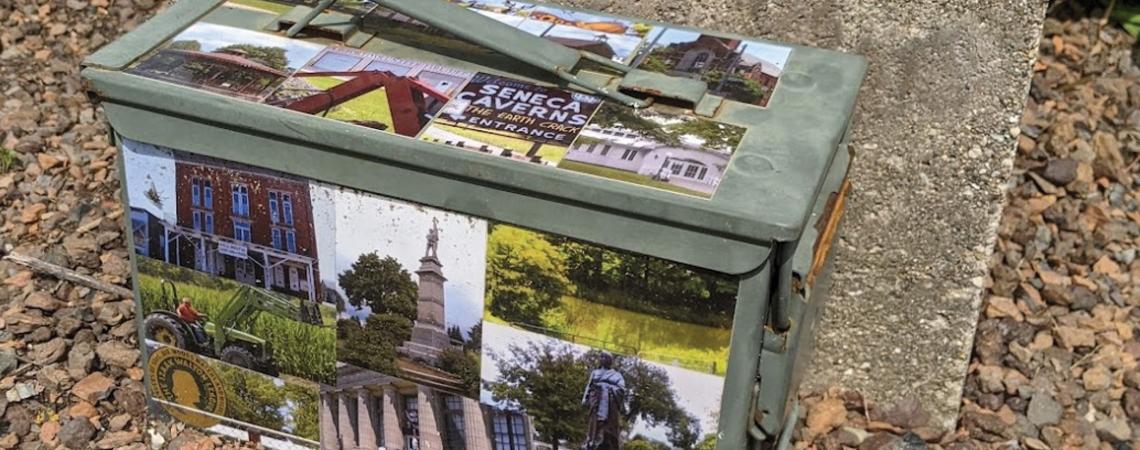Geocaching — a smartphone version of hide-and-seek — turns GPS technology into a family-friendly game for getting outside.
If you’re looking for a way to get your kids or grandkids out from behind their electronics and into the sunshine and fresh air, geocaching might be the hobby you seek. It combines physical exercise with the mental challenge of finding hidden caches.
Caches are hidden above ground. They can range from shoebox-sized containers to micro-caches a few inches long, but you’ll know what you’re looking for before you begin.
When it was created 22 years ago, it was described as a “high-tech treasure hunt,” and though geocaching has evolved over the years, the basic premise remains the same. GPS coordinates are used to track down caches, or “treasure” hidden in containers. From the first cache hidden near Portland, Oregon, the number of caches has grown in two decades to well over 2 million worldwide, according to www.geocaching.com, the hobby’s worldwide coordinator. There’s sure to be a few near you right now.
There’s no digging involved. Caches are hidden above ground. They can range from shoebox-sized containers to micro-caches a few inches long, but you’ll know what you’re looking for before you begin.
Getting started involves downloading the geocaching.com app on your smartphone ahead of time and making a plan. It’s free, but there’s a paid version that goes more in-depth for people who find they enjoy the hunt.
Also in preparation, gather a few small items — known as “swag” — to leave in the caches you find. Tiny caches don’t have items to exchange, but larger ones do. For example, if you have kids along, they might choose a small toy to take from a cache and leave one in return. Adults can find a piece of treasure for themselves and leave keychains, decorated rocks, or just about any small token in return.
Before setting out, explore the app or the geocaching.com website to find a few caches near your home or near the location you want to visit. There usually are lots of caches at parks, but they also can be found in towns, at historical sites, at businesses, and lots of other places. Each cache has a listing in the app that offers details and hints for finding it.
During the hunt, use your phone to navigate to the location shown on the map. It will get you within 30 feet of your prize. Then start searching. Larger caches are usually easier to find in the beginning. The app has a rating system that will give you an idea of the difficulty of the find and the difficulty of the terrain. Containers are sometimes left in the open, but others are cleverly hidden.
After you find a cache, take it a short distance away from its hiding place before opening to avoid giving away the exact location. It isn’t required that you exchange items in the cache, but finding “treasure” is fun, especially for kids. You can take a swag item and leave an item of the same approximate value, but nothing edible or perishable.
Sign the logbook with your geocaching.com username and the date, and then carefully close the cache and put everything back as you found it for the next person.
Some caches contain collectibles, trackable items, or geo-coins. In some cases, multiple caches must be found to solve a puzzle.
In the beginning, just know that if you take a “trackable” item, you have an obligation to place that item in a new cache within a week or two. “Trackables” have a unique tracking number that you can look up on the website to get details about where the item has been and where it’s going.
While geocaching is an activity unto itself, the game has been combined with other types of recreation such as bicycling, orienteering, and even paddling rivers and streams. There are organized events sponsored by state organizations such as Ohio Geocaching Association and regional groups.
Traveling Ohio’s geo-trails
In May, Coshocton Ring Trail launched, offering more than 40 caches based on J.R.R. Tolkien’s Lord of the Rings series. An exclusive coin can be earned by finding 16 of the caches and completing the passport with the code words and cache numbers. Passports are available at visitcoshocton.com with clues available at geocaching.com and on the geocaching app.
In fall 2021, Destination Seneca County launched its Seneca County Geo Trail, highlighting 20 sites in the towns of Tiffin and Fostoria, the rural villages across the county, historical places, and county parks.
To earn the official Seneca County Geo Trail coin, you must find 15 out of the 20 caches. Anyone who completes all 20 caches also receives a trackable tag. Complete a passport by finding the code words in each cache. Passports can be found online at www.destinationsenecacounty.org.
To find geocaches near you, simply sign up for a free (or paid) membership to geocaching.com and search for the area you want to visit by city name or county name (including “Ohio” or the state you want to visit for best results). Here is a small sampling of the many geocaching themes to be found in Ohio:
- Spirit Quest tours, which feature cemeteries
- Hocking Hills Adventure GeoTrail
- “Tour the World Cities” series, which can be found in cities/towns/villages with the same name as a foreign city
- Cache series with food-related themes such as doughnuts or coffee shops
- Cache series related to historical sites
- Challenge caches that require people to answer questions or solve puzzles that lead them to a cache










